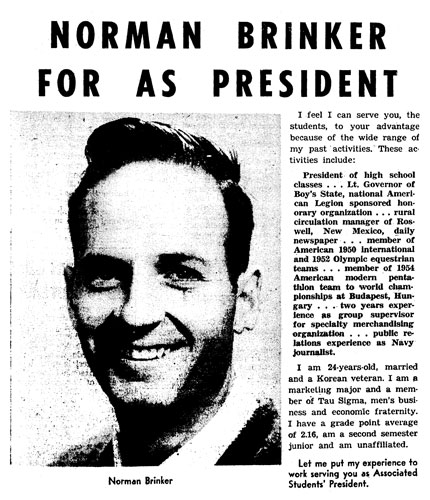Associated Students was formed in 1932, but the modern A.S. as we know it was born in 1955. That’s the year the first mandatory student activity fee was passed. That fee became instrumental in allowing the organization to provide all the services it’s known for; it also set the precedent needed to use fees to establish several campus landmarks, such as the Aztec Center, and later the Conrad Prebys Aztec Student Union.
None of that would have been possible without the leadership of Norman Brinker.
Brinker, who died at the age of 78 in 2009, is known today as a leader in modern restaurants. He most famously transformed Chili’s from a small chain into an international icon. But in 1956, Brinker was a married 24-year-old marketing junior, a Korean War veteran and a member of the Tau Sigma men’s business and economic fraternity. That year, the student body overwhelmingly approved the Universal Activities Fee, 2,971 student in favor to 889 against. According to The Aztec articles from the time, the fee provided the following benefits:
• A minimum-priced spouse card for non-student wives or husbands of regular students.
• Immediate voting privileges to all students so they may vote in the spring elections next week.
• Reduction in cost to $8 a semester.
• Contributions to a student union fund.
• A review of the student loan fund, which would allow maximum loans for students to cover registration costs.
• An effort to increase and enhance interdepartmental organization activities.
• An expanded A.S. social program.
According to an interview with Harvey Goodfriend in an A.S. website about its history, before the mandatory fee A.S. had to ask students to pay a voluntary student activities fee during registration.
Dr. Malcom A. Love, president of what was still known as the San Diego State College, said at the time the fee would help garner the college national recognition. The need for such a fee to allow student organizations and A.S. to grow seems obvious now, but it was not easy to pass. Four times in the five years leading up to the monumental vote in 1956, the universal fee was voted on and reject by SDSC students.
In the same issue of The Aztec announcing the passage of the fee, Brinker ran an ad announcing his candidacy for A.S. president. In a letter to the editor in the same paper he explained he had decided to run following encouragements and a letter to the editor asking him to do so. In a fortuitous foreshadowing, Brinker’s ad ran below an advertisement for a nearby Jack in the Box. Brinker would eventually become president of Jack in the Box.
Brinker went on to defeat Goodfriend, 953 votes to 883, for the A.S. presidency. He was quoted by The Aztec saying his main goal was to “present the college in the best possible light to outsiders and to students and to encourage more students to take an active part in their school.”
He also encouraged students to use a suggestion box to tell him what they wanted. A consummate leader, no task was too small for him and he took his pledge to heart. Later that year, he installed campus-wide pencil sharpeners and improved the cleaning of tables at the library as requested by students.
He also vowed to begin planning for a future student union building, a dream which was accomplished many years later thanks to the tradition of universal fees established that year.
Aside from his work for A.S., Brinker was a member of the 1950 and 1951 International Equestrian Team, the 1952 Olympic Equestrian Team and the 1954 American Modern Pentathlon Team that competed in the World Championships in Budapest, Hungary. He also spearheaded fundraising for the Refugee Student Fund for Hungarian students in 1954.
Photo from The Daily Aztec archives




